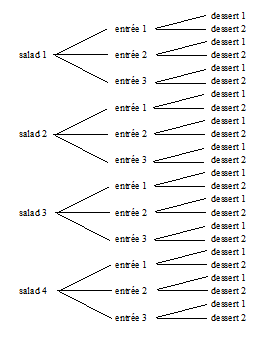


Let’s say that a person walks into a restaurant for a three course dinner. There are four different salads, three different entrees, and two different desserts to choose from. Assuming the person wants to eat a salad, an entrée and a desert, how many different meals are possible? Solution Looking at the tree diagram we can see that the total number of meals is 24. The first meal is salad 1, entrée 1, and dessert 1. The 24th meal is salad 4, entrée 3, dessert 2.
The Three Course Dinner example is easier to count the possible meals by using The Fundamental Counting Principle
If there are \(n_1\) ways to of choosing the first item, \(n_2\) ways of choosing the second item after the first item is chosen, \(n_3\) ways of choosing the third item after the first two have been chosen, and so on until there are \(n_k\) ways of choosing the last item after the earlier choices, then the total number of choices overall is given by \[n_1 \times n_2 \times n_3 \times n_4 \times n_5 . \times n_k. \label
Let’s look at the number of ways that four people can line up. We can choose any of the four people to be first. Then there are three people who can be second and two people who can be third. At this point there is only one person left to be last. Using the multiplication principle there are \[4 \times 3 \times 2 \times 1 = 24\, \text
The factorial of \(n\), read “n factorial” is \[n! = n(n-1)(n-2)(n-3). (2)(1).\] By this definition, \(0! = 1.\)
\[\begin 5! &= 5 \times 4 \times 3 \times 2 \times 1 \\[4pt] &= 120 \\[5pt] 8! &= 8 \times 7 \times 6 \times 5 \times 4 \times 3 \times 2 \times 1 \\[4pt] &= 40,320 \end\] Factorials get very large very fast. \[20! = 2.43 \times 10^ \nonumber\] and \[40! = 8.16 \times 10^. \nonumber\] 70! is larger than most calculators can handle.
The fundamental counting principle may seem like a very simple idea but it is very powerful. Many complex counting problems can be solved using the fundamental counting principle.
This page titled 12.1: The Fundamental Counting Principle is shared under a CC BY-SA 4.0 license and was authored, remixed, and/or curated by Maxie Inigo, Jennifer Jameson, Kathryn Kozak, Maya Lanzetta, & Kim Sonier via source content that was edited to the style and standards of the LibreTexts platform.